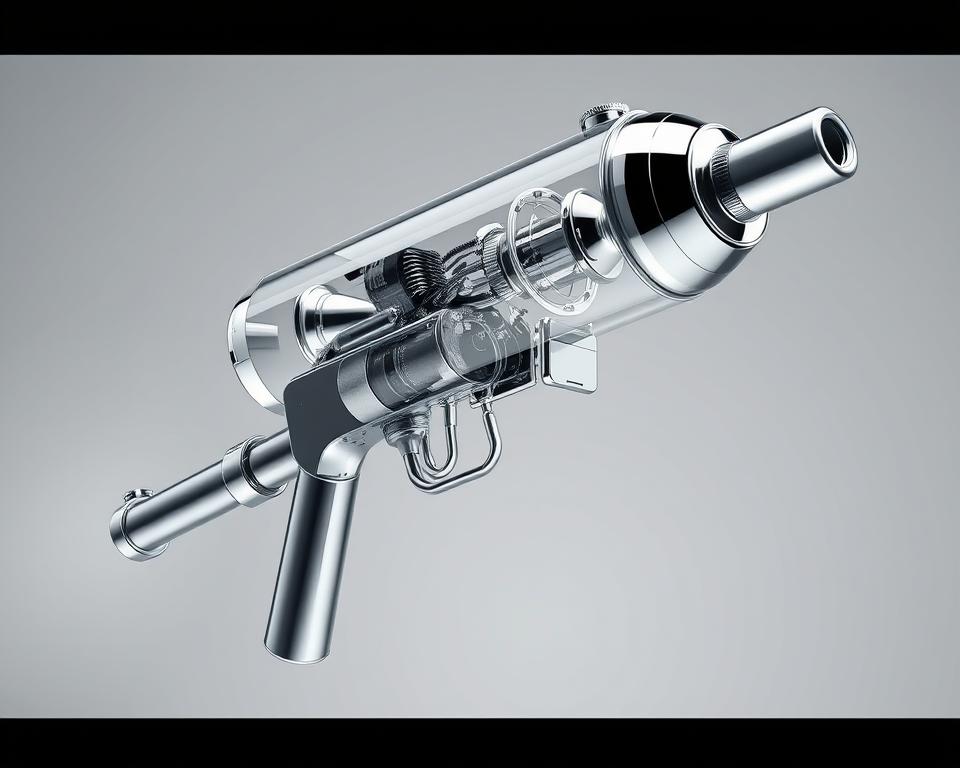Oxide of Chromium Green Applications in Refractories Discussed.
Are you aware that about 80% of the world’s chromium production goes into making refractory materials? Chromium oxide green, scientifically called Cr2O3, is remarkable for its exceptional properties. These properties render it crucial in high-temperature applications. It increases durability and resistance to oxidation in a range of production processes.
This article will delve into the broad applications of chrome oxide green in refractories. We will highlight its role in modern industry. Let’s discover why this multi-functional substance is so vital.
Introduction to Chromium Oxide Green
Chromium oxide green is a bright green compound renowned for its versatility and durability. It is important in the refractory industry due to its unique properties. This substance not only boosting the aesthetic value of manufactured goods, but also provides notable industrial gains for challenging industrial uses.
In the refractory industry, green chromium oxide is essential. It improves the high-temperature resistance and durability of products in harsh conditions. This covers applications in steel production and glass manufacturing. As sectors progress, the material’s significance grows, delivering benefits for extreme heat applications where endurance is critical.
Green chromium oxide is more than just a color additive; it’s a critical element for high-performance heavy-duty tasks. Its flexibility and resilience make it a key ingredient in the production of durable refractory materials.
Understanding Chromium Oxide and its Structure
Green chromium oxide, scientifically called Cr2O3, is a compound formed from chromium element and oxygen atoms. Its structure of chromium oxide displays unique features that enhance its application in different industries. This chemical configuration is sturdy and secure, providing strength in challenging environments.
The refractory properties of chromium oxide are exceptional in uses needing materials that tolerate high temperatures. It exhibits a robust power to withstand heat stress. This renders it ideal for metalworking and other industrial processes where thermal energy is vital.
Comprehending the details of the structure of chromium oxide assists sectors utilize its natural advantages. Its capacity to resist stress improves overall efficiency. This establishes chromium oxide as a leading candidate among heat-resistant compounds.
Importance of Chromium Trioxide in Refractories
Chromium trioxide is key for the efficiency of refractories due to its unique properties. It improves the stability and strength of these materials in extreme conditions. This insight is crucial for grasping its role alongside chromium oxide in various applications.
Role of Chromium Trioxide in Boosting Stability
Heat-resistant compounds need to tolerate intense thermal conditions without degrading. Chromium trioxide boosts their ability to resist heat and build quality. This leads to less damage, making it essential for industries needing reliable substances.
Comparison of Green Chromium Oxide and Trioxide of Chromium
Chromium oxide and chromium trioxide have distinct roles in refractory compounds. Both are crucial, but vary in their qualities:
| Property | Chromium Oxide | Trioxide of Chromium |
|---|---|---|
| Steadiness | Consistent thermal tolerance | Boosted heat resistance |
| Application | Frequently applied in refractories | Optimal for intense thermal scenarios |
| Strength | Average strength | Significantly boosts durability |
This comparison highlights the distinct roles of green chromium oxide and chromium trioxide to refractory materials. Their distinct properties improve performance and durability in a range of sectors.
High-Temperature Resistance Properties of Chromium Oxide Green
Green chromium oxide demonstrates exceptional traits, making it ideal for intense heat environments. Its melting point goes up to very high heat levels, providing unparalleled build quality in extreme conditions. This is crucial for companies needing strength, especially in metalworking industries.
Heat Tolerance and Strength
Green chromium oxide is famous for its high-temperature fusion point, important for keeping refractory structural integrity. This thermal endurance allows it to endure extreme heat without deforming. Its ability to resist melting makes it essential in environments that demand consistency.
Applications in Steel Smelting
In steel smelting, green chromium oxide’s thermal tolerance is invaluable. It’s often utilized in thermal-resistant building blocks for smelting ovens and heat chambers. These structural units endure extreme environments and must endure. Chromium oxide green’s heat resistance makes them effective, enhancing performance in metalworking.
Advantages of Green Chromium Oxide in Refractory Materials
Green chromium oxide notably improves heat-resistant products, crucial for a range of industries. It enhances mechanical properties and ability to endure oxidizing environments. These upgrades improve the durability and effectiveness of heat-resistant materials.
Improvement of Mechanical Properties
Adding chromium oxide green into refractories greatly enhances their mechanical properties. Main advantages are:
- Enhanced toughness: Green chromium oxide’s toughness increases materials’ ability to resist wear against damage.
- Enhanced wear resistance: Its structure lowers the impact of usage from constant wear, lengthening the lifespan of materials.
- Higher flexural strength: This characteristic allows thermal-resistant products to endure mechanical stresses, making it ideal for demanding applications.
Resistance to Oxidation in Heat-Intensive Uses
Chromium oxide green’s resistance to oxidizing conditions is vital in extreme heat settings. The advantages are:
- Extended longevity: Thermal-resistant substances endure more, surviving extreme conditions.
- Improved functionality: They suffer less damage, maintaining consistent efficiency in industries.
- Minimized replacement needs: Less material change of materials cuts costs for sectors using refractories.
These green chromium oxide advantages improve the durability of heat-resistant materials and support sustainability. They prolong product use and minimize environmental impact.
Understanding the Uses of Chromium Oxide Green in Refractories
Chromium oxide green has proven vital in a range of sectors thanks to its distinct properties. It is effective in various sectors, from steelmaking to ceramics manufacturing. Its role as a key ingredient in refractory materials highlights its importance.
Industrial Uses
Green chromium oxide is crucial in various fields for improved efficiency. Here are the primary fields and their particular applications:
- Steel Industry: It’s used in producing heat-resistant bricks and moldable refractory materials, offering temperature durability and resistance to wear.
- Glass Manufacturing: In thermal-resistant linings, it guarantees high temperatures and ensures chemical stability.
- Pottery Production: As a pigment in ceramic coatings, it provides coloration, durability, and structural integrity.
- Concrete Manufacturing: It improves the properties of thermal-resistant products for intense thermal applications.
Diverse Uses of Refractories
Green chromium oxide’s adaptability extends beyond single industries. Its applications span a broad spectrum, for example:
- High-performance refractory bricks
- Castable refractories for challenging settings
- Furnace coatings to prevent corrosion
- Heat-resistant ceramics
This broad application spectrum demonstrates green chromium oxide’s importance in improving manufacturing processes. Its exceptional features assist sectors adapt to current manufacturing needs, promising enhanced efficiency and long-lasting products.
Key Industrial Uses of Chromium Oxide Green
Green chromium oxide is essential in many fields, known for its versatility and efficiency. It is frequently utilized in the field of heat-resistant materials, improving temperature durability and mechanical strength. This substance is vital in substances designed for extreme conditions.
In the manufacture of refractory bricks and coatings, chromium oxide green is notable. These components are critical in high-temperature settings like kilns, furnaces, and burning devices. Utilizing chromium oxide enhances their functionality, ensuring they endure more and offer dependable use.
- Ceramics: Chromium oxide green is key in pottery, enhancing color stability and build quality.
- Metalworking: It is used in metal refining for instruments and components demanding thermal durability.
- Glass Manufacturing: In glassworks, chromium oxide green delivers the durability of glassmaking chambers.
This compound is important outside standard uses but also in new materials. The trend for energy-efficient solutions is encouraging its application in modern refractory materials.
As companies shift toward performance and productivity, chromium oxide green remains essential. Its extensive versatility shows its importance across various sectors. This demonstrates its value in the current heat-resistant material market.
Production Techniques of Chromium Oxide Green
The production of chromium oxide green uses several proven methods, each with distinct benefits and drawbacks. These approaches are crucial for manufacturing refined chromium oxide green, vital for its diverse applications. Techniques such as ignition, water-based, and solid formation play pivotal roles in manufacture and quality control.
Widely-Used Manufacturing Methods
Many typical manufacturing processes are used in green chromium oxide manufacture. These comprise:
- Burning Technique: This process involves the combustion of chromium-based materials with organic materials. It is efficient and has a minimal ecological footprint.
- Water-Based Technique: This method uses the chemical process of chromium compounds in an water-based mixture under intense pressure and thermal conditions. It creates highly crystalline materials.
- Precipitation Method: This process requires the precipitation of chromium compounds from aqueous solutions. It permits management over the size of particles and structure.
Each method offers unique advantages, such as affordability and expandability, but also comes with issues like quality and size inconsistency. Picking the best technique strongly influences the quality of the end product and its applicability for targeted roles.
Ensuring Quality in Manufacturing
Ensuring product quality is important in the creation of green chromium oxide. It makes certain the produced material meets industry standards for cleanliness and uniformity. Important areas of quality control consist of:
- Regular testing of starting compounds to guarantee good-quality components for green chromium oxide production.
- Oversight of process variables, such as thermal levels and pressure, during the multiple production processes.
- Produced material evaluation for chemical composition and traits, guaranteeing adherence with target characteristics.
Reliable monitoring techniques boost the trustworthiness and efficiency of green chromium oxide for its multiple uses. This highlights the significance of these manufacturing processes in the overall process.
Sustainability in the Production and Use of Chromium Oxide Green
The movement toward green practices is changing the production of chromium oxide green. Eco-conscious efforts is now a major priority as producers pursue strategies to reduce emissions. By incorporating sustainable practices, they lower harmful output and save natural resources.
Adopting eco-friendly methods into chromium oxide green production fulfills regulatory requirements and market expectations. Companies are now increasingly mindful of their effects on the planet. By adopting new technologies, they enjoy benefits such as:
- Employing recycled substances in manufacturing, which minimizes new resource extraction.
- Improving power consumption in the production process.
- Enhancing recycling practices to lessen damage to the environment.
Environmentally responsible usage of chromium oxide green is also clear in various sectors. For instance, it is instrumental in exhaust gas treatment systems, reducing toxic output. This shows the importance of eco-conscious practices in the refractory industry.
| Technique | Explanation | Environmental Benefit |
|---|---|---|
| Material Use | Employing waste materials in manufacturing | Minimizes raw material extraction |
| Energy Efficiency | Techniques to lower energy consumption | Cuts down on greenhouse gases |
| Pollution Management | Incorporating pollution control technology | Minimizes environmental contamination |
| Recycling Practices | Efficiently reusing by-products | Minimizes material waste |
As companies focus on sustainability, chromium oxide green production and application stand out. They show how green practices and technological advances can collaborate, setting the stage for a more eco-friendly tomorrow.
Future Innovations in Chromium Oxide Green Use
The field of refractory industry is headed toward significant transformation, notably with progress in green chromium oxide use. As industries aim for eco-friendly practices, the next phase of this compound takes on added significance.
New innovations are driving innovation in chromium oxide green’s applications, such as:
- Improved heat resistance for improved durability in extreme conditions.
- Innovative blends that increase its role in metallurgy and clay-based products.
- Innovative manufacturing techniques to reduce environmental impact while maintaining quality.
The incorporation of green chromium oxide into new heat-resistant materials promises effective solutions for global industries. Continuous research and development is set to leverage this material’s distinct characteristics. This ensures it stays important in cutting-edge refractory technology.
By capitalizing on these breakthroughs, industries can enhance the performance and eco-friendliness of their heat-resistant materials. This ensures the future of green chromium oxide very promising.
Summary
Green chromium oxide is a crucial material that improves the strength and performance of heat-resistant materials across diverse industrial sectors. Its exceptional properties, such as thermal tolerance and oxidation resistance, are important for the steel industry and pottery sectors.
The exploration of the uses of green chromium oxide showcases its adaptability and significance in modern manufacturing. Continued advancements in production increase its future uses, guaranteeing it continues to be essential for demanding roles.
As the trend toward eco-friendly production expands, the role of green chromium oxide is likely to expand. Its involvement in producing eco-friendly refractories highlights its essential part in the modern refractory industry. This promises increased efficiency and efficiency in a rapidly evolving manufacturing landscape.



